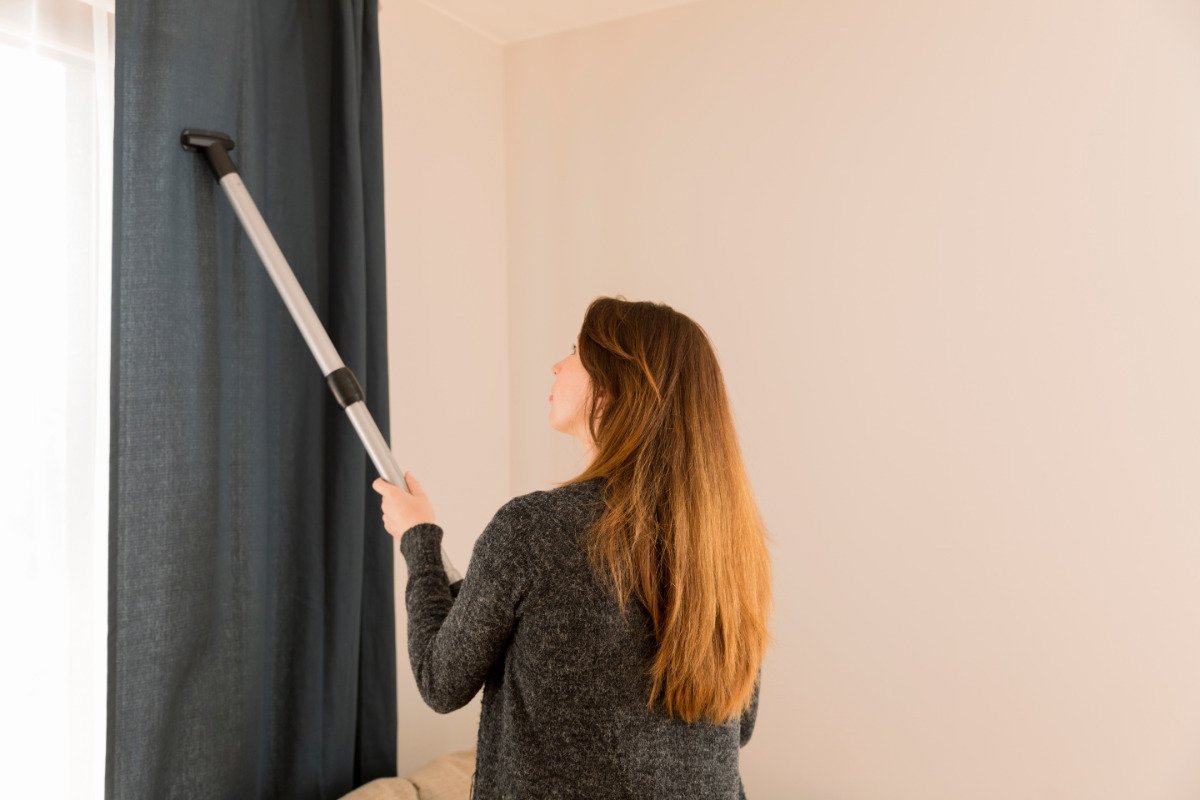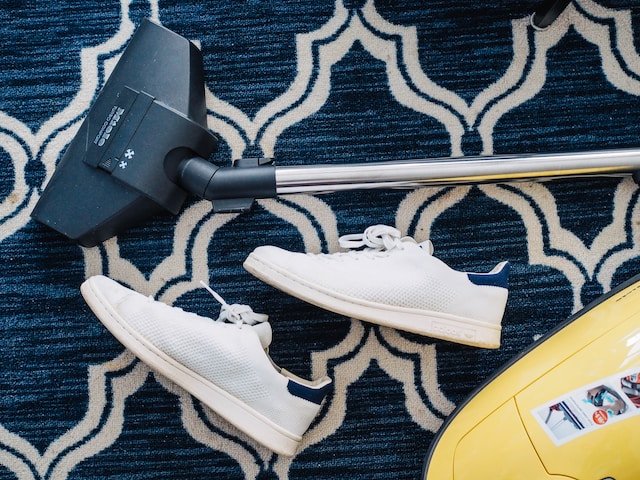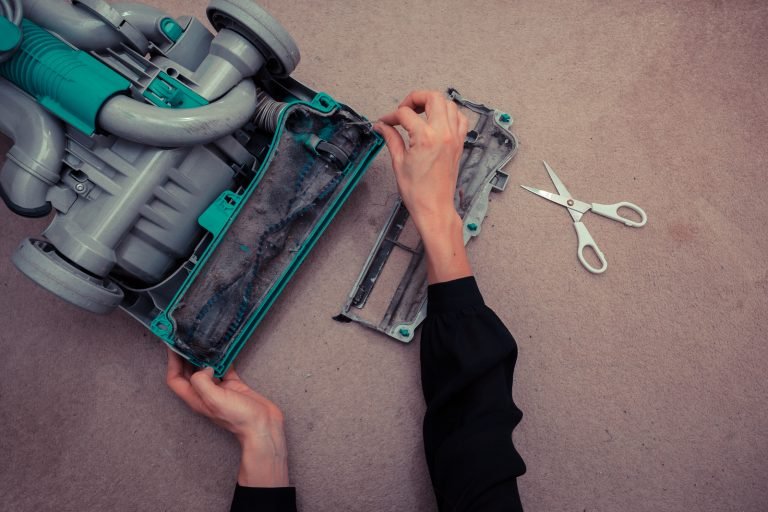Curtain Care 101: Learn How To Vacuum Curtains And Drapes

Do you wonder how to vacuum curtains and drapes? We all know the joy of throwing open our curtains to let the sunshine in, but have you ever considered giving them a spa day? Yes, you heard it right – your curtains deserve a spa day too! That’s why you need to learn how to vacuum curtains and drapes. A simple yet surprisingly satisfying way to breathe new life into your home decor.
Like your carpets and floors, these fabric wonders are magnets for dust, pet hair, and the occasional kitchen mishap. Fear not, though, because with your trusty vacuum cleaner and a sprinkle of curtain-care wisdom, you’ll soon be on the road to curtain cleanliness nirvana. Join us as we dive into the art of curtain vacuuming, making your home a haven of freshness and your curtains the stars of the show!
Understanding Your Curtains and Drapes

Before you begin vacuuming your curtains and drapes, it’s important to understand their different types and fabrics. This knowledge will help you determine the appropriate cleaning methods and care requirements.
Common curtain types include cotton curtains, synthetic curtains (such as nylon and polyester), silk curtains, and sheer curtains. Each type requires specific attention and precautions during the cleaning process.
By understanding your curtains’ characteristics, you can maintain their cleanliness and prolong their lifespan.
Types of Curtains and Drapes:
- Cotton Curtains: These curtains are durable and easy to care for. They can be machine-washed in cold water with mild detergent. Air-dry them or tumble dry on low heat.
- Synthetic Curtains: Nylon and polyester curtains are resistant to wrinkles and shrinking. Machine wash them on a gentle cycle with cold water and mild detergent. Air-dry on a low-heat setting.
- Silk Curtains: Silk curtains require delicate handling. Hand-wash them in lukewarm water with mild detergent. Air-dry and use a low-heat setting for ironing.
- Sheer Curtains: These delicate curtains can be washed in cold water with mild detergent. Hand-washing or using a delicate cycle in the washing machine is suitable. Air-dry them to maintain their brightness.
By familiarizing yourself with the different types of curtains and drapes, you can treat them with the appropriate care and maintenance.
Preparing for Vacuuming
Before you start vacuuming your curtains and drapes, it’s essential to prepare them properly. Follow these pre-cleaning steps to ensure a thorough and effective vacuuming process:
- Remove dust and debris using a soft brush attachment to your vacuum cleaner. Start from the top and work your way down, using short strokes. It will help loosen and dislodge any particles trapped in the fabric.
- If there are any stubborn stains or spills on your curtains, pre-treat them before vacuuming. Create a mixture of cold water and mild detergent and apply it to the affected area. Allow the solution to sit for a few minutes to break down the stain, then gently dab it with a clean cloth or sponge.
- Make sure you have the appropriate vacuum attachments for your curtains. An upholstery attachment is recommended as it provides a gentle suction that won’t damage the fabric. Attach the upholstery tool to your vacuum cleaner according to the manufacturer’s instructions.
By following these pre-cleaning steps and ensuring you have the right vacuum attachments, you’ll be ready to effectively remove dust and debris from your curtains and drapes.
How to Vacuum Curtains and Drapes

Below is the step-by-step guide on how to vacuum curtains and drapes easily and effectively to vacuum curtains and drapes, ensuring a healthier and tidier living environment.
1: Prepare Your Vacuum and Workspace
Before diving into curtain-cleaning action:
- Make sure your vacuum is ready for the task.
- Check that the dustbin or vacuum bag is empty, and if necessary, replace or clean the filters.
- Clear the space around your curtains, moving furniture if needed.
This preparation ensures a smooth cleaning process without any interruptions.
2: Dusting Off Loose Debris
Begin by gently shaking or using a soft brush to remove loose dust and debris from the curtains. This preliminary step prevents your vacuum cleaner from getting overwhelmed with large particles and ensures a more effective cleaning session.
3: Adjust Your Vacuum Settings
Not all curtains are created equal, and neither are vacuums. Adjust your vacuum settings to match the fabric of your curtains. Lower suction settings may be suitable for delicate fabrics, while heavier settings can tackle thicker materials. Proper adjustments help prevent damage and ensure efficient cleaning.
4: Start Vacuuming from Top to Bottom
With your vacuum settings adjusted, begin at the top of the curtains and work your way down. Use smooth and controlled motions, making overlapping passes to catch all the dust. Take your time, and pay extra attention to wrinkles and folds where dust tends to hide.
5: Addressing Curtain Accessories
If your curtains have tie-backs, valances, or other accessories, give them some attention. Use the appropriate attachments for your vacuum to clean these areas thoroughly. Dust and allergens can accumulate in these overlooked spaces, affecting the overall cleanliness of your curtains.
6: Vacuuming the Drapes
Moving on to drapes, follow a similar process. Start at the top and work your way down, paying attention to the folds and edges. Drapes often have thicker fabric, so ensure your vacuum settings suit the job. Take your time to achieve a thorough clean.
Now, you’ve successfully mastered the art of vacuuming curtains and drapes, transforming your living space into a cleaner and healthier haven. Regular cleaning removes visible dust and eliminates hidden allergens, contributing to a fresher and more enjoyable home environment. Incorporate this simple yet effective routine into your cleaning regimen, and enjoy the benefits of a space that looks and feels its best.
Dealing with Specific Curtain Types
When cleaning curtains, different types require specific methods to ensure their longevity and beauty. Here are some tips for cleaning different curtain materials:
➙Cleaning Cotton Curtains
For cotton curtains, start by pre-treating any stains. Then, wash them gently with cold water and mild detergent. After washing, tumble dry on low heat and iron out any wrinkles while the fabric is slightly damp. This will keep your cotton curtains looking fresh and vibrant.
➙Washing Synthetic Drapes
If you have synthetic drapes, such as nylon or polyester, they can usually be machine-washed. Use a gentle cycle with cold water and mild detergent. After washing, air-dry them on a low heat setting to prevent shrinkage. It will help maintain the quality and appearance of your synthetic drapes.
➙Caring for Silk Curtains
Silk curtains require more delicate care. Hand-wash them in lukewarm water with mild detergent. After washing, air-dry them and gently remove any wrinkles using a low heat setting. Taking these precautions will help preserve your silk curtains’ luxurious look and feel.
➙Maintaining Sheer Curtains
When it comes to sheer curtains, they can usually be washed in cold water with mild detergent. You can wash them by hand or use a washing machine on a delicate cycle. After washing, air-dry them to maintain their brightness and avoid any potential discoloration. Following these steps will keep your sheer curtains looking light and airy.
Post-Vacuuming Care
After completing the vacuuming process, a few important post-cleaning steps ensure your curtains and drapes stay in top condition. One common concern is wrinkles that may have formed during the cleaning process. To remove these wrinkles, gently iron the fabric on a low to medium heat setting while the curtains are slightly damp. Be cautious not to use excessive heat as it may damage the fabric.
Once your curtains are clean and wrinkle-free, it’s time to hang them back up. Proper drying and storage are essential to maintain the freshness and appearance of your curtains. Avoid excessive folding, as this can lead to creases and wrinkles. Instead, hang them up immediately after cleaning to allow them to dry properly and maintain their shape.
By following these simple post-vacuuming care steps, you can ensure that your curtains remain in excellent condition. Removing wrinkles and providing proper storage will help extend the lifespan of your curtains, keeping them looking fresh and appealing for years to come.
Frequency of Vacuuming

Establishing a regular vacuuming routine is crucial to maintaining the cleanliness and freshness of your curtains and drapes. By following a consistent cleaning schedule, you can ensure that your window dressings remain in optimal condition. Here are some guidelines to help you determine the frequency of vacuuming:
✔️Routine Maintenance:
- For general maintenance, it’s recommended to vacuum your curtains and drapes every week.
- Use an upholstery attachment to gently remove dust and allergens from the fabric.
- This regular vacuuming will help minimize the accumulation of dirt and prolong the cleanliness of your curtains.
✔️Deep Cleaning:
- Consider deep cleaning your curtains every 3-6 months for a more thorough cleaning.
- This deep cleaning is especially important for intricate or heavier curtain styles that may accumulate more dirt and allergens.
- Deep cleaning involves following the appropriate cleaning methods based on your curtain type, as discussed in Section 5.
By incorporating routine maintenance and periodic deep cleaning into your curtain care routine, you can effectively keep your curtains fresh and dust-free, enhancing the overall appearance of your home.
Additional Tips for Curtain Care
Proper care and maintenance of your curtains are essential to ensure their longevity and keep them looking their best. Here are some additional tips to help you maintain the beauty and functionality of your curtains:
- Preventing Sun Damage: Protect your curtains from harmful UV rays by using window coverings or opting for curtains made from sun-resistant fabrics. It will help prevent fading and discoloration caused by prolonged exposure to sunlight.
- Avoiding Excessive Cleaning: While regular cleaning is important, avoiding excessive cleaning is essential, especially for delicate fabrics like velvet and silk. Overwashing can cause damage and affect the fabric’s texture and color. Instead, opt for dry cleaning to preserve the integrity of these materials.
- Regular Inspection: Take the time to inspect your curtains regularly for any signs of wear, tear, or damage. Look for loose threads, missing hooks, or any stains requiring immediate attention. Addressing these issues promptly will help prevent further damage and ensure the longevity of your curtains.
By following these tips, you can effectively care for your curtains and keep them fresh and beautiful for years. Remember, proper curtain care is key to maintaining their cleanliness and enhancing the overall ambiance of your home.
Frequently Asked Questions
Can I use a vacuum cleaner to clean my curtains and drapes?
Yes, in most cases, you can use any vacuum cleaner to clean your curtains and drapes. However, adjusting the settings based on your curtain fabric is essential. For delicate fabrics, use lower suction settings to avoid damage.
Do I need to dust my curtains before vacuuming them?
Yes, it’s a good idea to dust your curtains before vacuuming. Gently shake or use a soft brush to remove loose dust and debris. It helps your vacuum work more efficiently and ensures a thorough cleaning.
Is it safe to vacuum delicate or sheer curtains?
It’s safe to vacuum delicate or sheer curtains. Just make sure to use lower suction settings and be gentle to prevent any damage to the fabric. Delicate fabrics can be effectively cleaned with the right vacuuming technique.
Can I use a handheld vacuum for small or spot cleaning on curtains?
A handheld vacuum is perfect for small or spot cleaning on curtains. It’s convenient and allows you to target specific areas. Use the appropriate attachment for your handheld vacuum for the best results.
Are there any alternative methods for vacuuming curtains and drapes?
If you don’t have a vacuum cleaner, you can use a lint roller or a soft brush to remove dust from your curtains. Regularly shaking out your curtains outdoors can also help. However, vacuuming is the most efficient method for a thorough cleaning.
Can vacuuming help prevent mold or mildew on curtains?
Regular vacuuming can help prevent mold or mildew on curtains by removing dust and moisture. Focus on areas prone to dampness, and consider adding ventilation to the room to discourage mold growth. Regular cleaning is key to keeping curtains mold-free.
Final Words
So, there you have it – the curtain-cleaning secrets are out, and it’s as easy as a Sunday morning! This simple yet effective cleaning routine can make a big difference in the cleanliness and freshness of your living space. Regular vacuuming removes visible dust and tackles hidden allergens, contributing to a healthier home environment.
Remember to adapt your vacuum settings to suit your curtain fabric, and don’t forget those often-overlooked areas like tie-backs and valances. Whether dealing with heavy drapes or delicate sheers, a well-executed vacuuming session can transform your curtains from dusty to delightful.
So, grab that vacuum, embrace the curtain spa day, and let your home be a testament to the beauty of simplicity. Here’s to cleaner curtains and brighter days!






